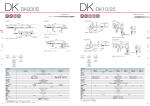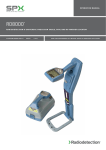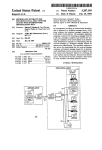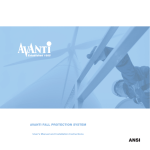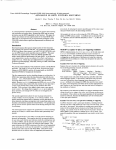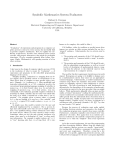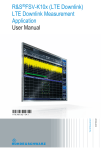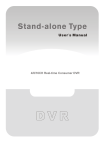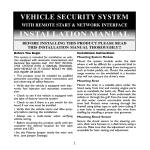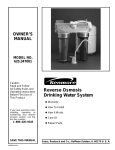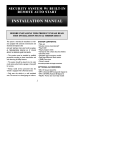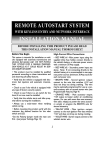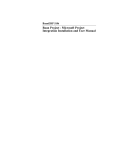Download Coalescing changes in pattern-directed, rule
Transcript
United States Patent [191
Loeb et al.
[54] COALESCING CHANGES IN
4,890,240
Dec. 26, 1989
Tools”, Addison-Wesley Publishing Co., copyright
PATTERN-DIRECTED, RULE-BASED
1986, PP- 608-632.
ARTIFICIAL INTELLIGENCE
PRODUCTION SYSTEMS
Chapter from Introduction to Expert Systems, Ad
ditons-Wesley, 1986, pp. 29-51, 126-141, Peter Jack
[75] Inventors: David J. Loeb, Campbell, Calif.;
son.
Advances in RETE Pattern Matching, Marshall I.
Schor et al, pp. 226-232, Proceedings of AAAI, 1986.
Keith R. Milliken, Croton Falls, N.Y.
[73] Assignee:
International Business Machines
Corporation, Armonk, N.Y.
[21] Appl. No.: 247,037
[22] Filed:
Sep. 20, 1988
Primary Examiner--Allen MacDonald
Attorney, Agent, or Firm-~Baker, Maxharn, Jester &
Mcador
[51]
Int. Cl.‘ ............................................ .. G06F 15/18
[52]
US. Cl. .................................. .. 364/513; 364/300;
[58]
Field of Search .............. .. 364/200, 900, 300, 513
[57]
ABSTRACT
A technique for collecting changes to working memory
364/200; 364/2745; 364/2747
[56]
Patent Number:
Date of Patent:
[11]
[45]
objects made by rule execution in an artificial intelli
gence production system avoids frequent use of a
References Cited
matching algorithm by delaying the match processing
PUBLICATIONS
of the collected changes to a memory object until com
pletion of an executing rule. A change to an object
wrought by execution of a rule is signi?ed in a control
block for that object. Once a ?rst change has occurred,
Programming Expert Systems in OPSS, An Introduc
tion to Rule-Based Programming, Lee Brownston, et
al, 1985.
A New and Efficient Match Algorithm for AI Produc
subsequent changes caused before execution of the rule
is complete will be made to the object and indicated by
the change block. When execution of the rule is com
plete, the changes coalesced in the object itself are reg
istered in the system by introduction of the changed
tions Systems, by Daniel Paul Miranker, Jan., 1987.
OPS 5 User’s Manual, Jul. 1981, Charles L. Forgy,
Department of Computer Science, Carnegie-Mellon
University.
Arti?cial Intelligence RETE: A Fast Algorithm for the
object into the matching algorithm.’ This avoids match
processing the object each time it is changed during
execution of the rule.
Many Pattem/Many Object Pattern Match Problem,
Charles L. Forgy, 1982.
Chapter from Distributed Computing, Academic Press,
1984, pp. 10-19, Chambers et al.
Aho et al., "Compilers: Principles, Techniques, and
RULE
8 Claims, 3 Drawing Sheets
34
a“:
INFERENCE
ENGINE
32
wonxmc
MEMORY
at
‘L
J
50
/
0o
COALESCED
EXECUTE
setecreu
causes
RULE
,
comm“
__._,i_
49
._
__.
AccuMuLAte.
|_
COALESCE
--—| _
cnauses
'
CLASS A’
,
W755 canes
(so
4
\eon
STACKME
\eoc
15o»
n-rsa uexr
PTR PTR
52
1
en
PTR
__
1'
ml
,
—‘| 64e: woemus
MEMORY
‘
no
1
Hl
,
323
50
52
FE
UPDATE
CHANGE
12
r—'——i
MAKE PTR
m.
I000 100a
I001: I001 ,-——-/
|
hpEl?tse
cm
RTSB
RTSB
met
PTR PTH PREV NEXT Next
MAKE PTR
‘
‘
i‘
a
J
I
\
70
162
MAK
H2
73° 73'
12
J
L
l,‘
_,
l
,
73°
\
uexr
PTR
I51
CA
HS
PTR
PTR
PTR PTFI PTR PTR PTR
3
a
l L
'
mo
69
'
NEXT ces MAKE UPD cnuc
\SOaIEOh
e0
5,
/74
73\ 7/3“ 73"
I500
r
RUN n
cusses
1
PTR PTRl FTR
\soo
CARED FOR
STACK
FIRST LAST RES
‘
I30
r
I00!
I00
'2'
/
m
‘
432
H3
INFERENCE ENGINE
r
US. Patent
Dec. 26, 1989
/'4
l
Sheet 1 Of3
4,890,240
INEERENOE ENGINE
RULE
'
BASE
_:
MATCH
_
CYCLE
flo
1
WORKING
/2O
‘
MEMORY
CONFLICT /22
sET
>"REOOONI2E—
ACT"
27
24
/
CONFLICT /
REsOLuTION
+
/26
ExEcuTE
SELECTED
CH‘ELGE To
-
<—-—
RUILE
.
CONTINUE‘ a
I
PRIOR ART
WORKING MEMORY
RULE
34
BASE
-
MATcI-I
_"
/32
>
/40
CYCLE
ENGINE
WORKING
*
MEMORY
CONFLICT
51/
/
._1__ _
r-
42
sET
I
30
INFERENCE
44
CONFLICT /
RESOLUTION
/
5O
+
/‘"S
00
COALESCED
EXECUTE
SELECTED
CHANGES
RULE
.
L
CONTINUE
49
/
CHANGE
wM
ACCUMULATE,
COALESCE
CHANGES
FIO.2I
‘*8
I
I
US. Patent
Dec. 26, 1989
Sheet 3 of3
4,890,240
SUBROUTINE Y
SUBROUTINE-
/32o
ROUTINE X
PROLOGUE
3%‘
+
WORKING
MEMORY
PARENT
/330
ROUTINE
P38523376
k———
/34O
3|Q
RULE
BASE
200
RECOGNIZE-ACT
_-
MATCH 1
220K
—ROUTINE
+
CONFLICT
DO-RETE+ we
230
+
PROCESSING
RESOLVE
360
N0
24o\ +
EX EiUTE
YES
""—'.
370
SUBROUTINE- /
EPILOGUE
+
‘
—
'--_
/3eo
oo- RETE PROCESSING
39o
;
_____1
25o\
"FLUSH" RETE
NETWORK
RETURN
CALLY
I
1
4, 890,240
COALESCING CHANGES IN
PATTERN-DIRECTED, RULE-BASED ARTIFICIAL
INTELLIGENCE PRODUCTION SYSTEMS
BACKGROUND OF THE INVENTION
This invention relates to arti?cial intelligence pro
conducts a procedure called con?ict resolution to select
the instantiation from the con?ict set to tire next. The
?ring of a rule by execution of its RHS can create,
duction systems, and more particularly, to a method for
uniting a sequence of changes to working memory ob
jects of such a system, while deferring matching of the
working memory to system rules.
change, or delete elements in WM and lead to changes
of the con?ict set. The inference engine of a rule-based
production system repeatedly executes, in a cycle, the
step of recognizing all instantiations in the con?ict set,
the step of resolving which instantiation of the step to
?re, and the set of firing the selected instantiation. The
Rule-based arti?cial intelligence production systems
signify computer programs written in a production
system language. A production system generally in
cludes working memory including a set of elements, a
cycle is called the “recognize-act” cycle.
Upon the firing of each rule, the inference engine
again determines the conflict set by computing using the
set of rules de?ned in terms of the elements, and a con
trol mechanism, or inference engine, which executes the
rules with reference to the elements. The control mech
anism matches the rules with the elements to produce a
con?ict set consisting of rules associated with matched
elements. The control mechanism resolves the con?ict
set by selecting the order with which the rules are exe
RETE algorithm. The RETE algorithm is expressed as
a sorting network. The LHS conditions of all rules in
the rule set are compiled into a sorting network includ
ing nodes, most of which are associated with tests. Use
of the network to recognize instantiations is called
“RETE” or “match" processing. In RETE processing,
tokens are passed through the network. Tokens that
traverse through the network represent instantiations in
or for the con?ict set. RETE processing is computa
outed, and “?res” the rules.
Rule-based arti?cial intelligence production systems
are known, as are languages which support their con
struction. Reference is given to: Brownston et al. “Pro
gramming Expert Systems in OPSS”, Addison-Wesley,
tionally expensive, amplifying the importance of pro
copyright 1985; Jackson, “Introduction to Expert Sys
duction system techniques that reduce it.
tems", Addison-Wesley, copyright 1986; Forgy, “OPS5
User’s Manual”, CMU-CS-8l-l35, copyright 1981; and
2
sists of the rule and list of CMs that satisfy the rule’s
LHS. The inference engine “?res” an instantiation by
executing the RHS of the rule, using the list of CMs in
the instantiation. The set of all instantiations available
for ?ring is called the con?ict set. The inference engine
30
Forgy, “RETE: A Fast Algorithm For the Mini Pat
tern/Mini Object Pattern Match Problem”, Arti?cial
Early rule-based production systems supported only
a ?xed sequence of actions in the RHS of a rule. This
restriction led to very short RHSs. This rudimentary
form of the RHS resulted in rules which rarely would
Intelligence, Vol. [9, copyright 1982.
make more than one change to the same CM during one
Brownston describes a rule-based arti?cial intelli
firing. The increasing use of high-level procedural lan
gence production system ("production system”) based
guage techniques for writing rules has led to the incor
poration of procedures such as subroutines, functions,
and coroutines in rule RHSs. In these cases, during the
upon a cycle of three states including matching-rule,
select-rule, execute-rule. Brownston points out that the
matching of elements to rules is the primary inefficiency
in the operation of a production system. The speed of
the inference engine of any such system is enhanced by
a reduction in the matching phase of the operation.
The matching phase in a language such as OPSS is
performed by a patterned network which systematizes
the association of system elements with the system rules
execution of a rule RHS where a high-level procedural
language is used, the execution of a procedure, and the
nesting of these frequently result in repeated changes to
a single CM in the execution of one RHS. As an exam
ple, suppose that in executing a RHS, a subroutine is
called. It is asserted that the program language allows
to select which rules are ready for execution. The 45 for the subroutine to be written using rule-based pro
matching algorithm utilized in OPSS is called the
duction system techniques. During execution of the
RETE method. The RETE matching procedure is well
subroutine many rules may fire, and in completing the
subroutine’s computations, many CMs may be created,
known, having been described, for example, in Forgy’s
Artificial Intelligence article. Rules (or “productions” or
changed repeatedly, and then deleted from working
“production rules”) have two parts, the LHS (left-hand
side, or if-part) and the RHS (right-hand side, or then
memory before return is made to the parent routine and
execution proceeds for the RHS that called the subrou
tine.
Customarily, it is standard to undertake RETE pro
part). Relatedly, a rule can be considered an if-then
statement of the form:
cessing immediately upon the making of any change to
lf conditions A, B, C are true, then take actions X, Y,
Z.
55 a CM. Therefore, the computational intensity--and
In a production system, the working memory (WM)
forms the universal data base of the system. Characteris
tically, the WM is segmented into classes, the classes
consisting of elements, or members, each member being
referred to as a class member (CM). Each rule of the 60
rule set has the two parts described above: LHS and
RHS. The LHS is a logical expression referring to
working memory classes, and the RHS is a list of opera
tions to be performed on CMs.
expense-of a production system will only be ampli?ed
by elaboration of RHS capability which permits com
pound actions and supports hierarchical routine execu
tion.
SUMMARY OF THE INVENTION
Classically, RETE processing is undertaken follow
ing any change to a CM. Unexpectedly, it was observed
by the inventors that changes to class members could be
The inference engine is the control mechanism that 65 ‘uncoupled from the corresponding RETE processing
and delayed. It was found that the delay practiced ac
RHS of a selected rule, repeating the cycle. The satis
cording to the invention frequently can reduce the total
fled rules are called instantiations. An instantiation con
amount of RETE processing.
selects rules to fire and then executes the actions of the
3
4,890,240
4
pletion of a recognize-act cycle, while accumulating
and uniting changes made to working memory objects
According to the invention, at the time a change is
made to a class member, a control block is created that
during that recognize-act cycle.
records the requirement for RETE processing. If an
other change is made to the same class member prior to
execution of the RETE processing, then only one con
trol block is needed to record both changes. Further,
the two changes can be united to effect one, possibly
Other objects and attendant advantages of this inven
tion will become evident when the following detailed
description is read with reference to the drawings.
BRIEF DESCRIPTION OF THE DRAWINGS
FIG. 1 is a procedural flow diagram illustrating the
larger change. Since the expense of the RETE algo
rithm is essentially independent of the size of the
change, total RETE processing can be substantially
reduced by reducing the two previously required passes
essential sequence of steps in the prior art, recognize-act
cycle of a rule-based production system.
FIG. 2 is a flow diagram illustrating the procedural
sequence of a recognized-act cycle according to the
through the RETE network to one.
A further point observed in the operation of rule
based subroutines is that repeated changes to a class
member may cancel each other out completely. Thus,
postponement of RE'I'E processing in a calling routine
in response to change of a CM in a called routine might
obviate the need for any RETE processing for that CM
invention.
FIG. 3 is an illustration showing the set of control
structures and control structure interconnections re
quired for practice of the invention.
FIG. 4 is a flow diagram illustrating the procedural
sequence of the invention in a rule-based production
in the calling routine. Meanwhile, in the called routine,
RETE processing is attenuated by postponement of 20 system in which routine calls are made during rule
execution.
RETE processing for the changed CM.
When processing an action which does not call or
DESCRIPTION OF THE PREFERRED
EMBODIMENT
In the speci?cation, the terms “make” and “create”,
contain a set of rules, the coalescing of changes will
provide an ef?ciency gain proportional to the number
of operations on a given CM. For an action calling or 25
“modify” and "update”, “remove” and “delete”, and
containing a rule set, the efficiency gain can be arbitrar
“class member”, “working memory element", and “ob
ily good. The improvement is proportional to the num
jec ” are used interchangeably. Further, the inference
ber of changes to given CMs, but there can be an arbi
engine of a rule-based arti?cial intelligence production
system includes a looping control mechanism termed
the “recognize-act cycle" whose fundamental opera
trarily large number of changes while processing the
called or embedded routine.
Accordingly, our invention is a method for coalesc
tional cycle includes the sequence match, select, exe
cute. See, for example, the Brownston reference at pp.
4-9.
ing changes to objects (CMs) in a working memory, the
method being invoked prior to processing these changes
through a working memory matching structure used in
con?ict set resolution, where such resolution occurs
In the prior art represented by FIG. 1; a rule-based
production system (production system) includes an
during the pattern match, rule select, rule execute cycle
of a rule-based arti?cial intelligence production system.
inference engine 10, a working memory 12, and a rule
memory or rule base 14. The structures, interconnec
The production system includes a memory for storing
tions, and functions of these elements are well explained
rules, and an inference engine cooperating with the
working memory and the memory for storing the rules 40 in the prior art references cited above. In the produc
tion system of FIG. 1, a set of rules in the rule base 14
for executing each cycle, each rule having pattern indi
is presented to a computer (not shown) in the form of an
cation and action specifying parts, the action specifying
part of a rule including procedures for effecting changes
application program written in a language such as OPSS
to working memory objects. The method includes the
steps of:
responsive to a ?rst change to an object resulting
from execution of a ?rst rule, creating a control block
(adapted for production system operation). The rules
apply to objects in the working memory 12 which rep
resent things or facts upon which the production system
operates. The inference engine 10 relates the set of rules
to the objects in working memory to determine the set
of all rules whose conditional (LHS) portions are satis
(CB) internal to the inference engine and recording that
?rst change in the created control block (CB);
enqueueing the control block;
50
?ed by objects in working memory. Preferably, this
matching is accomplished by means of a matching pro
in the event of a second change subsequent to the ?rst
change to the working memory object prior to selection
of the next rule following the ?rst rule, coalescing the
cedure based upon an ordered structure, such as a
and commonality of referencing to working memory
objects by the pattern indication portion of the rules.
working memory objects with the conditional parts of
RETE network. The RETE network for each rule is
established when the application program is compiled.
net effect of the ?rst and second changes in the queued
55 Hereinafter, this matching process will be synonymous
control block; and
with “RETE processing". Parenthetically, it is asserted
upon completing execution of the ?rst rule, passing
that structures and procedures other than RETE net
the change recited in the control block through the
works can be used for matching. In this regard, vectors,
matching mechanism.
lists, schemas, and frames are all matching constructs
This method reduces match processing, with the
reduction magni?ed by the degree of nesting of rules 60 utilized in prior art production systems for relating
rules.
The matching procedure of an inference engine pro
It is therefore an object of this invention to reduce the
amount of match processing required in a rule-based
arti?cial intelligence production system.
duces a conflict set. consisting of a set of rules all of
65
whose conditional parts are satis?ed by objects in the
working memory. The inference engine selects for exe
It is a further object of this invention to postpone
conduction of all matching procedures in a rule-based
cution one rule from the con?ict set, and executes the
arti?cial intelligence production system until the com—
selected rule. Rule execution involves taking the spe
5
4,890,240
ci?c action or actions enumerated in the RHS of the
selected rule. Most frequently, execution of the rule
requires modi?cation or creation of working memory
objects. In an OPSS-based production system, for exam
ple, rule execution adds, modi?es, or deletes one or
more memory elements in the working memory. In this
description, addition, modi?cation, and deletion are all
considered to “change” a working memory object.
Thus, if an object is made, updated, or deleted by execu
tion of a rule, the object is considered to be “changed”.
In FIG. 1, the recognize-act cycle of the inference
engine is understood in greater detail to include a match
cycle 20 which develops a con?ict set of rule instantia
tions 22, following which a con?ict resolution step 24
selects one of the con?ict set instantiations for execution
(“?ring”). In step 26 of the recognize-act cycle, the
selected rule is executed, usually resulting in changes to
working memory objects, represented by the line 27
6
changes to working memory objects while the execu
tion of the selected rule proceeds. When the execution
of the rule is complete, the positive exit is taken from
decision 48, the accumulated coalesced changes are
introduced to the working memory 32 by performing
the matching step 40. Again, as with FIG. 1, the deci
sion 48 is representational and corresponds to the post
ponement of RETE processing to alter the con?ict set
42 in response to the coalesced changes made during the
execution of the last-selected rule. Although the match
ing step 40 is implicit for each working memory object
which is changed, the advantage of the inference engine
illustrated in FIG. 2 is that multiple changes to a single
working memory object will require now only a single
response by the matching step 40. In contrast, in the
inference engine of FIG. 1, if, for example, two succes
sive modi?cations were made to the same object, each
change would initiate a match cycle. However, in the
originating at the execute step 26 and terminating at the
inference engine 30 of FIG. 2, successive changes to the
match cycle 20, indicating the match processing that 20 same data objects are coalesced, with the result that the
follows a change to working memory.
match cycle is undertaken only once for the changed
As pointed out on page 230 of Brownston et al., the
working memory object. It is to be understood, further,
prior art inference engine 10 will conduct a match cycle
that the inference engine 30 has the capability to co
in response to each working memory change resulting
alesce changes and postpone change processing for
from rule execution. Thus, several match cycles may be 25 each object changed in execution of the selected rule.
conducted during the execution of the single rule. The
In its industrial embodiment, the invention assumes
RETE processing required during the match cycle is
the existence of appropriate computer system hardware
expensive and time consuming. Therefore, any reduc
which can be programmed with an application defining
tion in such processing will enhance the effectiveness,
a rule-based production system. The rules of the pro
efficiency, and value of a production system.
duction system are compiled into a RETE network
In FIG. 1, the potential for conducting multiple
match cycle steps 20 is represented by the decision
structure for constructing and updating a con?ict set of
rules whose left hand sides are satis?ed by working
block 28. In this regard, assume that the production
memory objects.
system
match cycle
of FIG.
conducted
1 has resulting
been initialized,
in an andcon?ict
an
set
In the description which follows, the working mem
tive exit will be taken from decision block 28, and a rule
will be selected in step 24 and ?red in 26. Now assume
that the rule being executed results in a change to a
ing to our invention, whenever, in the course of rule
execution, a class member is changed, the indicated
actions are taken, in that the object is changed, but the
corresponding match processing is delayed. The re
quirement for match processing is recorded by the cre
35 ory objects are segregated into classes, with the objects
prior to the ?ring of the ?rst rule. In this case, the nega
in a class referred to as class members (CMs). Accord
working memory object before all of the actions speci
?ed in the RHS of the selected rule have been com
pleted. The working memory object change is recog
nized, and, as represented by line 27, the match cycle is
ation of a control block. If additional changes are made
to the class member during execution, then no addi
conducted, the con?ict set is updated, and the positive
tional control block is created. The ?rst control block
exit 29 is taken from the decision 28, permitting execu 45 suf?ces to re?ect the net of all the accumulated
tion of the selected rule to continue. Here, it is asserted
changes. In this regard, it is said that the ?rst control
that the decision block 28 is meant to represent an im
block “coalesces” the accumulated changes to a class
plicit feature of the inference engine of FIG. 1, and may
member during execution of a selected rule.
be undetectable in the code. Nevertheless, each work
For example, assume that the execution of a rule
ing memory change resulting from the execution of the
requires, ?rst, creation of a CM. This change is memori
selected rule will result in the match cycle being per
alized in the creation of a CB, and the CM is “made”.
formed, even if rule execution has not completed.
However, as rule execution is not complete, no RETE
FIG. 2 is a conceptual illustration of how an inference
processing is done in response to the “make”. The CB is
engine constructed using the teachings of this applica
enqueued in a “make” queue. Next, assume the CM is
tion can be distinguished in its operation from the prior
art inference machine of FIG. 1. In FIG. 2, a rule-based
production system incorporating the invention de
scribed below includes an inference engine 30, a work
ing memory (WM) 32, and a rule base (RB) 34. A
matching construct of the form of a compiled RETE
network is indicated by reference numeral 40. The
55
updated by changing one of its attributes. The second
change is undertaken by altering the attribute. Now,
however, no additional CB is created. Instead, when
rule execution is complete, the “make" CB results in the
updated CM being RETE processed. In this respect, the
"make” CB suf?ces to signify the “make” and “update”
changes, and its existence has “coalesced” the changes
in its single self. Now, only a single "make” RETE
match construct 40 produces a con?ict set 42 of instanti
ations, and a conflict resolution procedure 44 selects
process is required to match the updated CM with the
one of the con?ict set 42 for ?ring. The rule selected in
rule base. In the prior art, a “make” RETE process
step 44 is executed in step 46. A decision 48, implicit to 65 would have been conducted at the creation of the CM,
the execution step 46, responds to changes to working
followed by an “update” RETE process when the CM
memory objects by asking whether the execution step is
was changed. Thus, the invention, in this example, re
completed. If not, step 49 accumulates and coalesces the
duces the RETE processing by half.
4,890,240
7
8
In our invention, control objects are declared when
-continued
the application containing the production system is
compiled. It is understood that the objects in the work
ing memory are segregated into classes. Each class is
de?ned by a class anchor. At initialization of the appli
cation, the following declaration speci?es the class an
about class
5
Last, an entity called a care-for class block (CCB) is
declared by:
chor (CA) where ‘7"’ on any line delimits a comment:
1O
Declare CA.
t0p__RTSB_pointer,
CCB_staclt_p0inter,
?rst_CM__pointer.
1m_cM __pointer,
CA__pointer,
/' points to next CCB in queue
/' points to anchor of a class that
cares
/' points
RTSBs
/' points
/' points
queue
1' points
to top RTSB in a stack of
to Cared-for Clus queue
to ?rst class member in
to last class member in
All of the just-de?ned objects are understood to com
prise addressable locations in storage, which are desig
nated by well-known syntactic elements called “point
ers”.
If a rule RHS includes a call to a subroutine, function,
queue
Each class member (CM) has a header (CMH) which
is permanently associated with its class member. The
CMH is created and initialized with its CM. The ad
dress of the CM immediately yields the address of the
CMH, and vice versa. Speci?cally, the following define
the CMH:
Declare CMH,
Declare CCB,
neat__CCB__pointer,
/‘ declaration of a class member header
CA__pointer, /' points to the anchor for the class of CM
HIST0RY_stack_pointer-, /' points to the history stack of
CHBs for CM
A control block termed a run-time stack block
(RTSB) satis?es the following declaration:
or coroutine, these control entities enable the applica
tion to coalesce CM changes made during a call so that
the calling routine will be enabled to process these
changes. At the time a change is made to a CM, a CI-IB
is created that records the fact of required RETE pro
cessing. If another change is made to the same CM
before
the RETE processing is executed, then only one
25
CHB is needed to record both changes. During a sub
routine, a CM can be created, altered, and then de
stroyed before a return to the calling routine occurs. By
the time the flow of control returns to the caller, there
30 is no trace of the CM. The invention enables RETE
processing for the calling routine to be delayed until
control returns to the caller. To simplify the portion of
the discussion which follows, a de?nition is adopted. If
a routine has a rule whose LHS mentions a class, then
35 the RETE algorithm for that routine must process all
Declaration RTSB,
next_RTSB__pointer,
UPDATE_queue_pointer,
/' points to next RTSB in
stack
/‘ points to Cared-for
Classes queue
/‘ points to ?rst CHB of
type 'malte'
/' points to ?rst Cl-IB of
CHANGED_queue-pointer;
/' points to ?rst CHB of
CCB_queue__pointer,
MAKE_queue_pointer,
WW '“Pdlm'
changes to members of that class before conflict resolu
tion for that routine can be done. In this case, it is said
that the RETE network for the routine “cares about"
the class if some LHS in the routine mentions the class.
In FIG. 3, the interconnections between the control
objects necessary for the practice of this invention are
illustrated. In FIG. 3, the working memory 32 includes
a set of objects, separated into classes, one class of
which is termed class A. A CA 60 anchors a doubly
45 linked circular queue consisting of all of the CMs in
cluded in class A. The queue of class A include CMs
Change information regarding a CM is recorded in a
61-64. CA 60 includes at least three ?elds 60a, 60b, and
change block (CH8). The CHBs are the control blocks
60¢, each including a pointer. Field 600 includes a
which coalesce changes to class members. A change
pointer to the ?rst CM 61 of class A. The ?eld 60b
block is given by:
50 points to the last CM 64, while the ?eld 60c points to the
top RCB in a queue entitled the RTSB CARES stack.
Declare Cl-IB,
/' change block declaration
Each of the CMs 61-64 includes a class member
type
/' ‘make. 'update’, or ‘changed’
typed 'changed’
RTSB_pointer,
/' points to RTSB
CM _poiuter,
/‘ provides access to CM
and CMH
RTSB_next_pointer,
/’ next CHB in queue off
RTSB
RTSB_prev__pointer,
I‘ previous CHB in queue
off RTSB
HISTORY_stack_neat;
/‘ next CHF in stack
(HISTORY stack) oil‘ CMH
Next, a control object termed a run-time stack
“cares” block (RCB) is declared by:
header (CMH). The CMH of CM 63 is indicated by
reference numeral 69. The CMH 69 has a pointer (CA
55 PTR) to the CA 60 for the class A. The CMH 69 also
has a pointer (HS PTR) to a “HISTORY" stack of
CHBs for CM 63. It is understood that the detailed
structure illustrated for CM 63 describes also the struc
ture of the CMs 61-64, and every CM in the working
60 memory 32. Thus, every CM has a pointer to its own
private HISTORY stack, and every class anchor has a
pointer to its own private RTSB CARES stack.
In FIG. 3, it is presumed that the production system
has a hierarchical structure in that the RHS of any rule
Declare RCB,
next_RCB_in_stack;
/‘ points to next RCB in RTSB
RTSB_pointer~,
Cares stack off CA
/‘ points to an RTSB that cares
65 can contain a “call” to a subordinate routine or func
tion. The subordinate routine is considered to be on a
lower level of the hierarchy than the calling routine. In
FIG. 3, a stack termed the “RUN—TIME STACK" is a
9
4,890,240
10
linked list of data blocks which is pushed when a sub
routine is called and popped when the subroutine re
stroyed. Thus, there are no “removed" CHBs and no
turns to the caller. The blocks in this stack are the
given above regarding making and subsequently updat
RTSBs. The run-time stack of FIG. 3 includes four
RTSBs 70-73. The RTSB 70 is the RTSB of the pri
mary routine, that is the one first called in the hierarchy.
The routine owning RTSB 70 has called a routine own
ing RTSB 71, which, in turn has called a routine owning
RTSB 72. The routine owning RTSB 72 has called the
routine “PROCESS” 74 which owns the RTSB 73. The
RTSB 73 has a structure which is identical with the
structures of RTSBs 70-72. The RTSB 73 points to the
“removed” queues off of RTSBs. Recalling the example
ing a CM, if the make of the CM is indicated by creation
and enqueing of a “make” CHB for the top RTSB on
the RUN-TIME stack, the subsequent alteration of the
CM does not require creation of an "update” CHB.
Further, no additional change is made to the “make"
CHB. Likewise, if a CM currently existing when a rule
FOR CLASSES stack. Last, are three pointers 73c, 73d,
and 73e, which point, respectively, to a MAKE stack,
is executed is updated by the currently-executing rou
tine and “update” CHB for the top RTSB is created and
placed in the UPDATE queue RTSB and the history
stack of the CM. If that class member is changed again
during the current execution, the created “update”
CHB records alteration to the CM, and no change is
required for the CHB, nor is creation of a new “update”
an UPDATE stack, and a CHANGED stack.
CHB required. These two facts plus the handling of the
next RTSB (72) by a pointer (NEXT PTR) 73a. The
?eld 73b contains a pointer (CCB PTR) to a CARED
The MAKE, UPDATE, and CHANGED stacks are
“removed” described above are the features that “co
queues in which control blocks are stored that record
alesce" changes to CMs.
requirements for RETE processing. The control blocks 20 A “changed” CHB enqueued off of the top RTSB
in these queues are referred to as changed blocks
records that the pointed-to CM was previously either
(CHBs). The MAKE, UPDATE, and CHANGED
created or altered during the currently executing rou
queues are conventional linked lists whose members are
tine and that the RETE processing for these earlier
connected by pointers. For example, the MAKE stack
changes was completed. When the prior RETE pro
includes CHBs 110, 111, and 100. The UPDATE stack 25 cessing was completed, the previous CHB was removed
includes CHBs 120-122, and the CHANGED stack
from its make or update queue, the TYPE ?eld was
includes CHBs 130-132. Each RTSB has its own set of
altered to “changed" and the CHB was inserted into the
these queues, and does not share them with any other
CHANGED queue. If the CM is changed again, the
RTSB.
CHB is removed from the CHANGED queue off the
A CHB can be any one of three types: "make”, "up
top RTSB and the CHB is inserted into the UPDATE
date”, or “changed”. A record that a “make” must be
queue for the same RTSB. Concurrently, its TYPE ?eld
pushed through the RETE algorithm is kept with a
is changed to “.update”. This re?ects that additional
“make” CHB; a record of an “update” is kept in an
RETE processing now needs to be done.
“update” CHB; and a record that the class member was
The HISTORY stack for a CM contains every CHB
changed and that the appropriate RETE processing has
built for the CM. Thus, the HISTORY stack of the CM
been completed is kept in a "changed" CHB. Exem
may contain different CHBs for different RTSBs. When
plary of the CHBs in the MAKE, UPDATE, and
a HISTORY stack contains multiple CHBs, they will be
CHANGED stacks is the CHB 100 having ?elds
enqueued off of di?‘erent RTSBs, giving the HISTORY
1000-100f1 The ?eld 1000 contains a code (TYPE) that
stack of CHBs a one-to-one correspondence with a
indicates which type of CHB this one is. For example, 40 subset of the RTSBs on the RUN-TIME stack. This
?eld 100:: of the CHB 100 will contain a code indicating
one-to-one correspondence preserves order between
that it is of the "make” type. A pointer to the RTSB
the RUN-TIME and HISTORY stacks. The RTSBs
which owns this CHB is in ?eld 1006. In this case, the
that correspond to CHBs on the HISTORY stacks are a
CHB is owned by the RTSB 73. Next, the CM to which
subset of those RTSBs whose routines “care about” the
this CHB pertains is pointed by a class member pointer 45 class in which the CM is contained. However, the CHB
(CM PTR) in ?eld 1000. The previous and next CHBs in
HISTORY stack for a CM may not have a complete list
the MAKE queue off of the RTSB 73 are pointed to by
?elds 10% and 100e, respectively. Last, it is asserted
that the CM PTR ?eld of each CHB associates each
of all the routines which care about the class of the CM.
For example, suppose the RETE network of routine X
cares about class A, and X calls routine Y, and a mem
CHB with one, and only one, CM in the working mem 50 ber of class A is created in Y. While execution remains
cry 32. Further, a HISTORY queue is maintained for
in Y, there is no history of the new class member in
each CM to which the CHBs of the CM belong. Thus,
routine X’s RETE network and there is no CHB for the
each CHB belongs to two queues: the MAKE, UP
new class member enqueued off of the RTSB of routine
DATE, or CHANGED stack of the RTSB owning the
X. When routine Y returns to routine X, it could be
CHB, and to the HISTORY stack of the one CM with
determined (for example by searching) if routine X‘s
which it is associated. In FIG. 3, the CHB 100 is thus a
RETE network does indeed care about the new class
member of the MAKE stack linked to the RTSB 73, and
member. However, in the invention, the RTSB CARES
also a member of the HISTORY stack for the CM 63.
stack enqueued off of the class pointer record which
The HISTORY stack of the CM 63 consists of the CHB
RTSBs “care about" that class. Thus, when routine Y
100 and CHBs 140 and 141.
returns to routine X, the fact that the RETE network of
' Coalescing of changes to working memory objects
routine X does contain reference to class A can be de
can be further understood with reference to the
termined quickly by “walking” the RTSB CARES
MAKE, UPDATE, and CHANGED queues and the
stack of class A.
CHB of FIG. 3. In the embodiment being discussed, if
The RCS PTR in ?eld 60c of the class anchor 60
the CM is removed, then the “removed” RETE pro
points to the top block in the RTSB CARES stack for
cessing is done immediately (ignoring any earlier
class A. RCBs are in the RTSB CARES stack. When
changes that are pending and recorded in CHBs).
ever the RUN-TIME stack is pushed (that is, whenever
Thereafter, all CHBs for the removed CM are de
a subroutine is called), if the RETE network for that
4,890,240
11
subroutine cares about a class, then the RTSB CARES
stack is also pushed by addition of an RCB to the top of
that stack, pointing to a new RTSB. In this regard, the
RTSB CARES stack for class A consists of link-listed
RCBs 150-152. Each RCB includes at least two pointer
?elds, corresponding to the ?eld 150a and 1501: of the
RC3 150. In ?eld 1500 is a pointer to the RTSB of a
routine which cares about class A. In ?eld 15% is a
pointer to the next RCB in the RTSB CARES stack.
As stated above, calling a routine results in pushing a
RTSB onto the RUN-TIME stack, and an RCB onto
the RTSB CARES stack for each class that the called
routine cares about. Fast access to all of the classes that
the routine cares about is provided in the CARED
FOR CLASSES stack. In FIG. 3, this stack includes
CCBs 160-162. Each CCB in this stack includes at least
two ?elds corresponding to ?elds 160a and 1601; of
block 160. The ?rst ?eld includes a pointer (CA P’I'R)
to the class anchor of one of the classes cared for by the
called routine. The second ?eld points to the next CCB
(NEXT) in the stack.
In the discussion of FIG. 3, the terms “list”, “queue”
and “stack”, have been used interchangeably to indicate
linked sequences of blocks. Some of these sequences
have an order corresponding to the hierarchy of rou
tines in the production system application. It is asserted
that all of these sequences are generated using conven
tional means at initialization time for the application,
and that they are processed using conventional routines
during execution of the application. The invention is not
an invention of lists, queues, or stacks, but rather relies
upon these well-known structures for its practice.
The practice of the invention is not limited to produc
tion systems which use routine calls in RHS execution. 35
In its simplest application, the invention is useful in
production system applications which may not use calls
but which do recognize and execute compound RHSs.
In this, the simplest case, the structure of FIG. 3 would
illustrate a single
RTSB
and
12
5. When a routine is called, upon entry into the rou
tine, the RETE network for the called routine must
process all members of all classes that the RETE net
work of the routine cares about, the processing being
done as “makes” for all CMs of the cared-for classes.
When the routine is exited, the routine’s RETE net
work is ?ushed by "removing” every number of every
class that the RETE network cares about.
Utilizing the control block and control block connec
tions of FIG. 3, the method of coalescing changes ac
cording to the invention can be described in more de
tail.
When a class member is created, a “make” CHB is
also created. The CHB is enqueued in the MAKE queue
of!‘ of the top RTSB in the RUN-TIME stack. The CHB'
is also pushed onto the HISTORY stack anchored in the
CMH of the class member created. If additional
changes to the CM precede con?ict resolution for the
routine, then those changes are coalesced into the make
operation, and nothing further is done to the CHB until
the made CM is subjected to RETE processing.
When con?ict resolution is required, the MAKE
queue of the top RTSB is walked. In this regard, the
MAKE queue is traversed in order from top to bottom,
with the “make” of each CM having a CHB in the
queue being pushed through the RETE network. Each
time the CM linked to aCHB in the MAKE queue is
subjected to a match cycle, the CHB is moved from the
MAKE to the CHANGED queue.
If a CM is removed, then the RETE processing for
removal is done immediately for all active routines
caring about the class of the class member and having
RTSBs on the run-time stack. All CI-IBs for the class
member are removed from their respective queues and
destroyed. If creation or changes occurred before the
remove request, but after the proceeding con?ict reso
lution step, all RETE processing for the creation and
/or updating is avoided.
If multiple changes are made in succession to an al
a CARED-FOR
ready existing CM, then the already existing Cl-IB for
CLASSES stack pointing to all classes of the working
memory and an RTSB CARES stack with a single RCB
that CM is moved for the ?rst change from the
CHANGED queue to the UPDATE queue, with the
pointing to the single RTSB. In this fundamental utiliza
tion, MAKE, UPDATE, and CHANGED queues
appropriate change being made to the TYPE ?eld of
changes and defer changes until completion of execu
tion.
However, when the invention is applied in a produc
con?ict resolution is ?nally required to proceed to the
next rule to be ?red, the UPDATE queue is ?rst
walked, the “update” RETE processing done for each
CM changed in a respective match cycle, and the CI-IBs
the CHB. No CHB modi?cations need occur for those
would still serve to, for each rule execution, coalesce 45 changes made after the ?rst update to the CM. When
tion system supporting RHS calls to subroutines, a set of
assumptions are made. First, if any routine in a hierar
chy of routines has a rule whose LHS mentions a class,
are all moved back to the CHANGED queue.
The CHANGED queue is maintained principally to
then the RETE algorithm for that routine must process
ensure that termination of a routine will not prevent
all changes to CMs of that class before con?ict resolu
coalesced changes being passed back to the caller for
tion before the routine can be done. In this respect, it is
processing in the caller’s RETE network. Suppose rou
said that the RETE network for this routine “cares 55 tine X called routine Y and that routine Y has run to
about” the class if some LHS in the rule base for the
completion. Now, the ?ow of control returns from
routine mentions the class. With this, the following
routine Y to routine X. More speci?cally, the RHS of
some rule (say rule RR) in routine X which contained
assumptions apply to the routines:
the call to routine Y now must complete execution.
1. Each routine has its own, separate RETE network.
2. There is a separate con?ict set that is created when 60 Other actions can occur subsequent to the return, but
before execution of rule RR is complete and RETE
a routine is called, and deleted when the routine returns
processing initiated in order to begin con?ict resolution.
to its caller.
For example, the call may be to routine Y in a loop
3. Recursive calls to a subroutine of data-driven rules
where it would be repeated many times. Advantage is
networks for the called routine, one network for each 65 gained through the practice of the invention if the
changes made to class members that routine X cares
level of nesting of the routine.
about are not immediately processed by routine X’s
4. The run-time stack is pushed when a routine is
RETE algorithm. Instead, the invention coalesces
called and popped when the routine is returned.
will only be supported by creating additional RETE
13
4,890,240
changes made in routine Y with changes made earlier in
routine X.
Coalescing upon return to a calling routine is done by
walking each of the MAKE, UPDATE, and
CHANGED queues off of the called routine’s RTSB.
Given a CHB in one of routine Y’s MAKE, UPDATE
or CHANGED queues, if that CHB is the only CHB in
the related CM’s HISTORY stack, then the CM must
have been created inside routine Y (or in a routine
called by routine Y). In this case, speedy determination
can be made as to whether routine X cares about this
new CM by looking at the RTSB Cares stack for the
CM's class anchor. If routine X cares about the class
containing the newly made CM, the CHB goes into the
MAKE queue for routine X. Similarly, if a routine
hierarchically positioned between routine Y and routine
X cares about the class, the CHB goes onto that rou
tine’s MAKE queue. Otherwise, the CHB is destroyed.
14
memory objects which are made, updated, or removed
as part of rule execution. In addition, the course of
execution may include a call (call Y) to subroutine Y.
Assuming no call to routine Y or return of control from
Y, the match and con?ict set steps 210 and 220 are
preceded by a call to a routine 250 entitled
do_RETE_processing.
The routine do_izgm_processing is illustrated in
Table I. In Table I, the routine, for each CHB in the
routine RTSB’s UPDATE queue calls the RETE pro
cessing of steps 210 and 220 with the RETE network of
the top RTSB and the CM pointed to by the CHB and
a command to perform UPDATE processing as param
eters. Next, the CHB is moved to the CHANGED
queue and its type is set to CHANGED. Then, for each
CHB in the MAKE queue, the RETE processing rou
tine of steps 210 and 220 is called using the RETE net
work of the top RTSB, the CM pointed to by the CHB,
If the CHB is not the only CHB on the CM’s HIS
TORY stack, then either the next older CHB is associ 20 and the MAKE routine as parameters. Next, the CHB is
moved to the CHANGED queue and its type is set to
ated with routine X or it is associated with the routine
CHANGED.
that is hierarchically positioned between routine X and
Following the CALL Y from the execute step 240 in
routine Y. That is, the routine is positioned before X but
FIG. 4, the production system routine for subroutine Y
after Y on the call chain. Which possibility is easily
determined by comparing the RTSB PTR in the CHB 25 is entered. Upon entry into subroutine Y, step 320 is
invoked. Step 320 consists of a called routine sub
with the address of routine X’s RTSB. If routine X
routine-prologue, and is followed by the do_RETE._
cares about the class containing the CM, then there
processing routine 330. The subroutine_prologue step
must be a CHB queued of!‘ of routine X's RTSB because
320 is illustrated in greater detail in Table II. Sub
of the assumption that all members and all classes that
routine_prologue is executed as part of the prologue of
routine X cares about would be created (pushed
each called data-driven routine in the production sys
through routine X’s RETE network as new CMs) when
tem. The primary function is to invoke RETE process
routine X was called. If there is a CHB enqueued for
ing for all members of classes that the routine cares
routine X, then it is necessary only to move back the
about and to push all the stacks needed for coalescing
CHB to routine X’s UPDATE queue if it was formerly
changes. When this routine is complete it returns to the
on routine X’s CHANGED queue. Likewise, if there is
called routine which then calls the recognize-act cycle.
a CHB enqueued for a RTSB below X on the RUN
As Table II illustrates, an RTSB for the routine is
TIME stack, then the CHB in its CHANGED queue
needs to be moved to the routines UPDATE queue. In
all cases, the HISTORY stack is popped to eliminate the
CHB for routine Y.
When routine Y returns to routine X, the RUN
TIME stack is popped, and, concurrently, the CARED
built and pushed onto the RUN-TIME stack. A new
RC8 is created and pushed onto the RTSB CARES
stack for each CA speci?ed by the CARED-FOR
CLASSES queue of the routine. Then, for each CM in
the queue of class members off of the CA speci?ed by a
FOR-CLASSES queue is walked to quickly locate each
CCB in routine Y's CARED-FOR-CLASSES queue, a
class anchor that routine Y cares about. For each of
new CHB is created, pushed onto the HISTORY stack
these routines, RTSB CARES stack is popped to re 45 for the associated CM and enqueued on the MAKE
move the RCB pointing the popped RTSB for each
queue off of the routines RTSB. The subroutine_.
such class anchor.
prologue routine then calls the do_RETE_processing
When routine X calls routine Y, the reverse steps are
routine of Table l to process all of the “makes” in rou
taken. The RUN-TIME stack is pushed. The CARED
tine Y’s MAKE queue. In this manner, Y’s RETE net
FOR-CLASSES queue is walked, and for each class
work is
with all CMs from WM 301 about
CCB, two actions are taken for the designated class
anchor. First, the RTSB CARES stack is pushed with a
which Y cares. This is required to initiate production
system processing by subroutine Y.
Next, subroutine Y begins its production system oper
new RCB pointing to the RTSB pushed on to the RUN
TIME stack. Second, each queue of CARED-FOR
ation by calling a recognize_act._routine 340, illus
CLASSES is walked to create the CMs used by routine $5 trated in greater detail in Table III. The recognize__ac
Y and each HISTORY stack is pushed with the new
t_routine assumes that the application sets a ?ag to
CHB in that stack also being enqueued in the RTSB’s
indicate when routine is to be passed to the caller, rou
MAKE queue.
tine X. Such a flag can take the form of a control ele
The operating procedure just described is illustrated
ment such as is used in OPSS programming. The routine
in FIG. 4 where routine X is embodied in a parent rou 60 of Table III initially selects a rule to execute, and then,
tine 2410 implementing a recognized-act cycle including
assuming there is an instantiation to tire, ?res the instan
process steps 210, 220, 230, 240, and 250, in sequence.
tiation. Execution of the rule in subroutine Y is carried
RETE processing is implemented in the MATCH step
out by the application code which will take actions to
210 and to produce the conflict set 220. A rule to ?re is
make, update, and remove CMs during execution. Flag,
selected in RESOLVE step 230 and the rule is executed 65 or control element processing is also carried out by the
in step 240 by executing the instantiation selected in step
application during rule execution in order to inform the
230. During the course of executing the instantiation,
application when to return control to the caller of sub
the application code will initiate changes to working
routine Y.
4,890,240
15
16
During rule execution, the recognize_act_routine
the UPDATE queue for RTSB speci?ed by the RC8
may be required to execute, update, or remove a CM. If
on the classes RTSB CARES stack. Then, the CH8 is
these actions are required, they are taken in conjunction
with the respective routines of Tables IV, V, and VI.
destroyed for this routine the RUN-TIME stack is
popped the RETE network for the routine is “?ushed”
in step 300 by executing a remove for all of the class
members in the class WM 301 that Y cares about, and
control is returned (step 390) to routine X.
'I‘hus,whenanewCMismadeduringtherecog
nize_act_routine 340, the make procedure is per
formed and the execute_a_make procedure of Table
IV is called. The procedure of Table IV records the
TABLE I
need for RETE processing of a “made" CM in a CHB.
do_RETE_proceasing:
When the CM is made, it isassumed that it contains an 10
Do for each CHB in ‘update’ queue;
indication of the class to which it is to belong. Using this
indication, the CA for the class is located, the CA is
inserted into the class member queue off of the class CA
and a make “CHB” is created and
Call RETE processing routine with top RTSB‘s
RETE network and CI-IB’s CM and ‘update’
as parameters;
move CHB to ‘changed’ queue and set CHB's type to
for the
'changed';
CM, pushed onto the CM’s HISTORY stack and in
serted into the MAKE queue off of the top RTSB.
When an existing class member is changed by updat
ing, the change is made and the execute_and_update
procedure of Table V is called. Recall that, under the
earlier description, if a routine is currently executing
End;
Do for each CI-IB in ‘make’ queue;
Call RETE processing routine with top RTSB’s
RETE network and Cl-IB's CM and 'make'
20
and cares about a class, then for each CM in the class
there must exist a Cl-IB in the MAKE, UPDATE, or
CHANGED queues of the routine. Thus it is known
as parameters;
move CHB to ‘changed’ queue and set CHB’s type to
.chmsed';
End;
End do_RETE_processing;
that a CHB must exist in one of these three queues at the
TABLE II
time the t'rmction of Table V is invoked. Furthermore, if
the located CHB is not in the CHANGED queue, then
subroutineJrologue: indenti?er of routine is passed parameter,
the need for RETE processing is already recorded, this
change is thereby coalesced with the already recorded
push run-time stack, i.e., add and
a new RTSB;
Do for each CC]! on Cared-for Classes queue for routine;
push a new RCB on RTSB cares queue oil‘ CA
change, and there is nothing more to do.
speci?ed by CCD with RCB pointing
In this embodiment, "remove” processing is not im 30
plemented by the CB strategy. While “remove” could
be enqueued with the hope that a later "make” could be
coalesced with a given “remove” to reduce total pro
cessing, our embodiment preferably eliminates all traces
“remove"
is
performed,
the
push CH8 onto history stack for CM;
enqueue CI-IB in 'make' queue otl' top RTSB;
End
Call do_RETE_processing; /‘ to process all the ‘makes’
operation. Thus, CHBs are not enqueued for “re
moves".
a
the CA speci?ed by CCB;
create a CHB for each CM;
End;
of a CM as soon as the application requests a “remove”
When
to the new RTSB;
Do for each CM in queue of class members o?‘
End subroutine_prologue;
ex
ecute_a_remove procedure of Table V1 is called, the
TABLE III
CHB in the UPDATE or CHANGED queues are lo
cated, the CM is removed, the CHB is dequeued from
recognize__act_routine:
the MAKE, UPDATE, or CHANGED queue of the
current RTSB and the CHB is popped off the CM’s
HISTORY stack and destroyed. Last, the CM is de
stroyed and the routine ends.
Returning to the recognize_act_routine of Table II,
when the selected instantiation has completed ?ring, the
do__RETE_processing routine (Table I) is called in
step 350. When the RETE processing of step 350 is
completed, if the return ?ag has not been set, (step 360),
Do until a ?ag is set indicating application wants to return
to caller;
Call con?ict-resolution; /' select the best instantiation
45
to ?re
If there is a best instantiation
50
Then
?re the beat instantiation;
/' Note that during the course of ?ring
/' the instantiation, the application code
/' will initiate changes to working memory.
I‘ The application code will call
the recognized_act_routine is performed again in step
/' execute_a__make, execute_an_update. and
340. It‘ the flag has been set, the subroutine-epilogue of
step 370 is called.
The subroutine_.epilogue is illustrated in Table VII,
and is executed as part of termination of each routine,
/' execute_a_rernove as part of its make,
/' update, and remove actions.
including subroutine Y. The epilogue pops the top RCB
I‘ A flag will be set by the application
/' when the application wants to return to
/' the caller of the currently active,
/‘ data-driven subroutine.
Else
off of the RTSB CARES stack for each class listed in
Return to the caller of recognize_act_routine;
the CCB for the current RTSB. Then, for each CI-IB on
Call do_RETE_processing
the MAKE, UPDATE, and CHANGED queues
End;
Return to the caller of recognize_act_routine;
pointed to by the top RTSB, the CH3 is popped out of 60
End of recognize__act_routine;
the HISTORY stack for its associated CM and de
queued from its RTSB queue. If the HISTORY stack
for the CM is empty and the RTSB CARES stack for
TABLE IV
the CM’s class is not empty, the CH8 is changed to a
CM is passed parameters;
MAKE and placed on the MAKE queue of the RTSB 65 Execute_a__rnske:
use class name or other identi?er to locate anchor (CA)
speci?ed by the top RTSB on the RTSB CARES stack
of the class. Otherwise, the top CHB on the HISTORY
insert CM into class member queue o?' CA;
stack is converted to a CHANGED CHB and moved to
create and initialize a CHB for the CM;
class;
for
17
4,890,240
,
18
in the event of a second change to said object sub
sequent to said ?rst change and prior to the se
TABLE IV-continucd
push CHB onto history stack o?' CM;
insert CHB in 'make’ queue off top RTSB in run-time stack;
lection of the next rule following said ?rst rule,
maintaining said CB unaltered in said queue,
without passing either said ?rst or said second
End execute_a_mnke;
changes through said matching mechanism; and
TABLE V
execute_an_update: CM is passed parameter;
If the top CHB on CM‘s History Stack is on 'changed’ queue
Then move CHB to the ‘update’ queue
10
and change type of CHB to ‘update’;
End execute__an_update;
upon completing said execution of said ?rst rule,
passing the change recorded in said CB through
said matching mechanism.
2. The method of claim 1, wherein said ?rst change is
a creation of said object, said enqueueing step including
enqueueing said CB in a make queue.
3. The method of claim 1, wherein said ?rst change is
an update of said object, said enqueueing step including
TABLE VI
15 cnqueueing said CB in an update queue.
execute_a_remove: CM is passed parameters;
Do for each CHB on History Stack anchored at CM;
4. The method of claim 1 wherein said enqucucing
step includes enqueueing said CB in either a make or an
If CHB is in an 'update' or ‘changed’ queue
update queue.
5. The method of claim 4, further including the steps
Then Call RETE processing routine with CHB’s RTSB's
RETE network and CM and ‘remove’ as parameters;
dequeue CHB from make, update, or changed queue;
pop CHB of!’ history stack;
20 of:
responsive to said passing step, enqucueing said CB in
destroy CHB;
a changed queue; and, then,
upon selection of a second rule following said first
rule, recording a third change to said object occur
destroy CM;
End execut_e_a_remove
25
TABLE VII
subroutine_epilogue:
Do for each CCB on Cared-for queue of!‘ RTSB;
pop RTSB cares stack for the CA speci?ed by CCB;
End;
Do for each CH1! on make, update, and changed queues
of!‘ top RTSB;
pop CHB out of history stack for CM of C83;
dequeue CHB from mnke/update/changed queue;
ring before selection of the next rule following said
second rule by moving said CB from said changed
queue to said update queue.
6. The method of claim 5 further including the step
of:
30
in the event of a fourth change to said object subse
quent to said third change and prior to the selection
of the next rule following said second rule, main
taining said CB unaltered in said update queue,
If history stack is empty, and RTSB cares stack is not empty
without passing either said ?rst or said second
Then /' pushing a make thru earlier routines in call
changes through said matching mechanism; and
chain '/ creates CHB on ‘make’ queue of RTSB
upon completing said execution of said second rule,
passing the change recorded in said CB through
said matching mechanism.
7. A method for coalescing changes to objects in a
working memory, the method being invoked prior to
processing said changes through a matching structure
used in con?ict set resolution, said resolution occuring
during the recognize-act cycle of a rule-based, arti?cial
speci?ed by top RCB on the RTSB cares stack;
Else IF top CHB on history stack is ‘changed’
Then move CHB to ‘update’ queue for same RTSB
and set CHB’s type to ‘update’;
destroy the CHB;
End;
pop run-time stack;
End subroutine_epilogue;
Obviously many modi?cations and variations in the 45
practice of this invention will occur to the skilled practi
tioner which do not depart from the spirit and teachings
of this description.
We claim:
1. A method for coalescing changes to objects in a 50
working memory, the method being invoked prior to
processing said changes through a matching structure
used in con?ict set resolution, said resolution occurring
during the recognize-act cycle of a rule-based, arti?cial
intelligence production system,
55
gine cooperating with said rule set and working
memory for executing a succession of recognize
act cycles, each rule having pattern indication and
action specifying parts thereof, the action specify
ing part of a rule including procedures for effecting
changes to said objects,
said method comprising the steps of:
responsive to a ?rst change to an object resulting
from execution of a ?rst rule, creating a control 65
enqueueing said CB in a queue;
said system including a rule set and an inference en
gine cooperating with said rule set and working
memory for executing a succession of recognize
act cycles, each rule having a pattern indication
and an action specifying part, the action specifying
part of the rule including procedures for making
changes to said objects,
said method including the steps of:
creating a ?rst queue for a production system calling
routine, and selecting and executing a ?rst rule
said system including a rule set and an inference en
block (CB) internal to the inference engine and
recording said ?rst change in the created CB;
intelligence, production system,
during said calling routine;
in an action-speci?ying part of said ?rst rule, calling
and executing a rule-driven, production system
subroutine including a subroutine rule set, a sub
routine working memory with working memory
objects which said subroutine cares about, and a
subroutine matching structure used in subroutine
conflict set resolution;
creating a second queue for said subroutine;
responsive to a ?rst change to an object in said sub
routine working memory rcsulting from execution
of a rule in said subroutine working set, creating a
?rst control block (CB) for said object and record
ing said ?rst change in said CB;
19
4,890,240v
20
ii’said calling routine cares about said object, moving
enqueueing said ?rst C13 in said second queue;
said ?rst CB to said ?rst queue if said ?rst queue
contains no second CB for said object, and passing
said ?rst and second changes through said match
in the event of a second change to said object occur
ring during the execution of said rule of said sub
routine working set, maintaining said ?rst CB unal 5
ing structure;
tered in said second queue, without passing either
otherwise, dequeueing and destroying said ?rst CB.
8. The method of claim 7, further including the step
said ?rst or said second change through said sub
of creating a third queue for said calling routine, and if
routine matching structure;
said ?rst queue includes a second CB for said object,
upon completing said execution of said rule in said
moving said second CB from said ?rst to said third
subroutine rule set, passing said ?rst and second
queue and passing said ?rst and second changes through
changes through said subroutine matching mecha
said matching structure in response to the inclusion of
said second CB in said third queue.
nism in response to said CB; and
alter return to said calling routine:
Q
15
25
35
45
50
65
i
C
I
i














